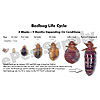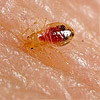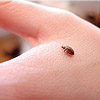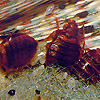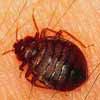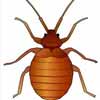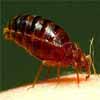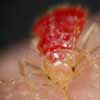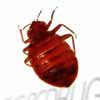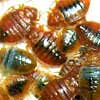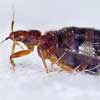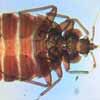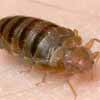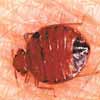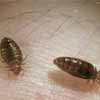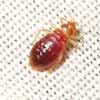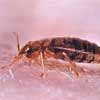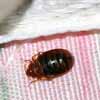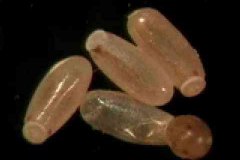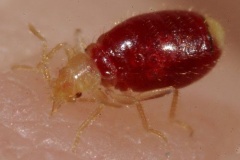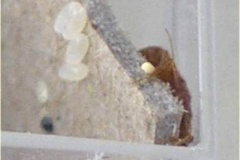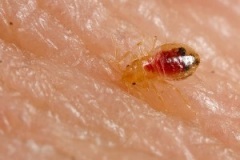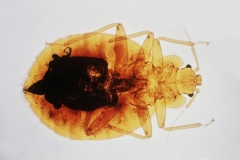Bed bugs
 Bed bugs are small wingless insects that feed solely upon the blood of warm-blooded animals. Bed bugs and their relatives have evolved as nest parasites. Certain kinds inhabit bird nests and bat roosts and await the return of their hosts; others have adapted well to living in the '˜nests' (homes) of people. Hatchling bed bugs are about the size of a poppy seed, and adults are about 1/4 of an inch in length. From above they are oval in shape, but are flattened from top to bottom.
Bed bugs are small wingless insects that feed solely upon the blood of warm-blooded animals. Bed bugs and their relatives have evolved as nest parasites. Certain kinds inhabit bird nests and bat roosts and await the return of their hosts; others have adapted well to living in the '˜nests' (homes) of people. Hatchling bed bugs are about the size of a poppy seed, and adults are about 1/4 of an inch in length. From above they are oval in shape, but are flattened from top to bottom.
Their color ranges from nearly white (just after molting) or a light tan to a deep brown or burnt orange. The host's blood may appear as a dark red or black mass within the bug's body. Because they never develop wings, bed bugs cannot fly. When disturbed, bed bugs actively seek shelter in dark cracks and crevices. Cast skins of bed bugs are sometimes discovered. Although such a finding confirms that bed bugs had been present previously, it does not confirm that any continue to infest the residence. Thus, inspect carefully for live crawling bed bugs. Because many other kinds of small brown bugs may be discovered, it is critical to ensure that the bugs are correctly identified.
They will usually bite once a week or so, and they can actually live for a long time without feeding - usually six months, but sometimes over a year.
 Bed bugs can infest all kinds of different places in your bedroom. Most often they're in the mattress - in the seams, the box springs, or sometimes the linens. However, they can really be anywhere near where people sleep - furniture within crawling distance, carpet, books, phones - they've been found in all kinds of random things, because they don't create a nest, they just hide somewhere.
Bed bugs can infest all kinds of different places in your bedroom. Most often they're in the mattress - in the seams, the box springs, or sometimes the linens. However, they can really be anywhere near where people sleep - furniture within crawling distance, carpet, books, phones - they've been found in all kinds of random things, because they don't create a nest, they just hide somewhere.
Bed bugs used to be nearly completely eliminated in the United States, Canada, and Western Europe - largely because of DDT and because of certain chemicals used against roaches. In recent years, however, there have been rising levels of infestations because
Can bed bugs hurt me?
No, they aren't actually dangerous. However, the bites are annoying and they can cause skin irritation and rashes, especially if you've got a lot of them in the mattress. So it's always a good idea to get rid of them - because each bug can lay four or five eggs a day, leading to a pretty big batch of them if you leave things alone.
Bed bug infestation complaints in New York City have been on the rise, and are expected to continue to rise, if drastic preventative measures are not taken! Did you know that NY bed bug infestations have been reported in public housing, shelters, daycare centers, and even upscale hotels? And did you know thatover 80% of bed bug infestations are found in the mattress or box spring?
 Over 80% of bed bug infestations are found in the mattress or box spring! You can be pro-active and take preventative steps to avoid bed bug infestations in your home by protecting your bedding. The problem with bed bugs is that they infiltrate every aspect of your family's life. Even the most basic necessity, a good night's rest, can no longer be taken for granted. With the rapid increase in bed bug infestation, bed time is now fraught with anxiety. Read the tips below and learn what steps to take to protect your home and family.
Over 80% of bed bug infestations are found in the mattress or box spring! You can be pro-active and take preventative steps to avoid bed bug infestations in your home by protecting your bedding. The problem with bed bugs is that they infiltrate every aspect of your family's life. Even the most basic necessity, a good night's rest, can no longer be taken for granted. With the rapid increase in bed bug infestation, bed time is now fraught with anxiety. Read the tips below and learn what steps to take to protect your home and family.
Bed bug infestations are on the rise in New York City.
New York is known for many things'“it's known for its nightlife, great food, winning sports teams, and Broadway plays, to name but a few NY attractions. NYC is known as the city that never sleeps... but with SecureSleep'„¢ anti-bed bug encasement products, now they can! Watch this space as this page will keep you informed andhelp you stayclear of bed bug infestations. New York Pest Control Professionals are very busy these days, with a variety of treatments for bed bug infestations '“ some effective, some not. But statistics show that 52% of U.S. pest control firms routinely utilize bedding encasements in bed bug treatment protocols. Bed bugs arenocturnal parasites that have resurfaced in New York City. Theycan be hard to detect, but once you have them you will need an exterminator to get rid of them. Find out what you need to know.
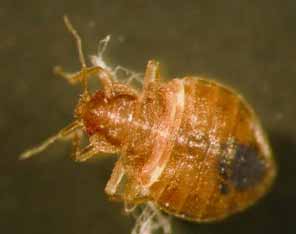 And in cities like New York, where neighbors are often separated only by bricks and mortar, one person's infestation is everybody's problem, since bed bugs can crawl through walls and along wiring and pipes, and hitchhike on clothing, furniture, luggage and more. In this city of 8.3 million, it seems as if everyone has a bed bug story. Just ask Gale A. Brewer, a self-appointed bed bug evangelist and a City Council member from the Upper West Side. She prodded the Mayor's office to convene a bed bug advisory committee last fall, after years of what she and others felt were woeful public policy inadequacies in the face of the relentless advances of what some have called 'œthe pest of the century.' (The committee '” entomologists, civic policy experts and advocates for children, the elderly and others '” will issue its recommendations next month.)
And in cities like New York, where neighbors are often separated only by bricks and mortar, one person's infestation is everybody's problem, since bed bugs can crawl through walls and along wiring and pipes, and hitchhike on clothing, furniture, luggage and more. In this city of 8.3 million, it seems as if everyone has a bed bug story. Just ask Gale A. Brewer, a self-appointed bed bug evangelist and a City Council member from the Upper West Side. She prodded the Mayor's office to convene a bed bug advisory committee last fall, after years of what she and others felt were woeful public policy inadequacies in the face of the relentless advances of what some have called 'œthe pest of the century.' (The committee '” entomologists, civic policy experts and advocates for children, the elderly and others '” will issue its recommendations next month.)
Related Links
Bed Bug Bites, bed bug Images, History and Evolution of Bed Bugs.

 Residence
Residence  Location
Location 

 Due to the difficulty in eliminating the bugs from the room or dwelling, the (suspected) bed is isolated, thus removing the insects' food source'”humans. Bedbugs cannot crosspetroleum jellyand have difficulty climbingmetalorglass, hence each of the bed legs is put in atincan(the bottom of which is thickly coated with petroleum jelly) to avoid movement from the bed to the hiding places. Although bedbugs cannot fly, they have been observed climbing a higher surface in order to then fall to a lower one, such as climbing a wall in order to fall onto a bed. They can also jump a few centimeters, and so could jump from the wall onto the nearby bed. Hence alternatively, a double-sided stickytape(such as carpet tape) is applied around each bed leg, or to keep each leg on a plastic furniture block in a tray of water. However, this does not prevent bugs from biting you on your couch or in other areas of your dwelling.
Due to the difficulty in eliminating the bugs from the room or dwelling, the (suspected) bed is isolated, thus removing the insects' food source'”humans. Bedbugs cannot crosspetroleum jellyand have difficulty climbingmetalorglass, hence each of the bed legs is put in atincan(the bottom of which is thickly coated with petroleum jelly) to avoid movement from the bed to the hiding places. Although bedbugs cannot fly, they have been observed climbing a higher surface in order to then fall to a lower one, such as climbing a wall in order to fall onto a bed. They can also jump a few centimeters, and so could jump from the wall onto the nearby bed. Hence alternatively, a double-sided stickytape(such as carpet tape) is applied around each bed leg, or to keep each leg on a plastic furniture block in a tray of water. However, this does not prevent bugs from biting you on your couch or in other areas of your dwelling. 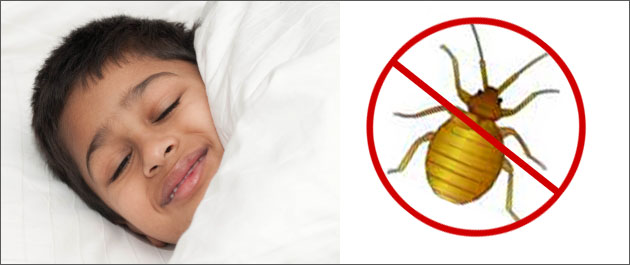
 A disinfected bed can be isolated and protected by applying a layer of duct tape around each leg of the bed'”using regular duct tape that has been curled lengthwise over on itself with the sticky side out. This creates a simple yet sticky barrier that will prevent most bedbugs from being able to crawl up the legs and onto the bed. This barrier technique may also be used in multiple strips or rows placed side by side to create an even stronger barrier (in areas where an infestation is heavy or where there exists a higher chance that bedbugs will attempt to crawl over the sticky tape). However, in using duct tape as a barrier, it is usually necessary to first place down a protective layer of some sort to prevent the duct tape from damaging the surfaces adhered to as well as to the prevent the duct tape barrier from leaving behind a sticky residue once it is finally removed. This protective layer, if used, can be created by placing a layer of painter's tape (also called masking tape) around the legs of the bed first'”before placing the duct tape. The painter's tape will help protect the surfaces wherever the 'curled duct tape' barrier is placed as the duct tape is adhered only directly over top the protective layer of painter's tape. Also, as a substitute to masking tape, plastic wrap can be wrapped tightly around the legs of a bed and used as the initial protective layer instead (where the curled duct tape is then placed over the plastic wrap).
A disinfected bed can be isolated and protected by applying a layer of duct tape around each leg of the bed'”using regular duct tape that has been curled lengthwise over on itself with the sticky side out. This creates a simple yet sticky barrier that will prevent most bedbugs from being able to crawl up the legs and onto the bed. This barrier technique may also be used in multiple strips or rows placed side by side to create an even stronger barrier (in areas where an infestation is heavy or where there exists a higher chance that bedbugs will attempt to crawl over the sticky tape). However, in using duct tape as a barrier, it is usually necessary to first place down a protective layer of some sort to prevent the duct tape from damaging the surfaces adhered to as well as to the prevent the duct tape barrier from leaving behind a sticky residue once it is finally removed. This protective layer, if used, can be created by placing a layer of painter's tape (also called masking tape) around the legs of the bed first'”before placing the duct tape. The painter's tape will help protect the surfaces wherever the 'curled duct tape' barrier is placed as the duct tape is adhered only directly over top the protective layer of painter's tape. Also, as a substitute to masking tape, plastic wrap can be wrapped tightly around the legs of a bed and used as the initial protective layer instead (where the curled duct tape is then placed over the plastic wrap). Bed bugs provide an interesting and compelling example of a conflict of interest between mates. Generally, scientists have assumed that both male and female parents have similar interests in reproduction. However, bed bugs mate in a peculiar manner that is advantageous for males but downright dangerous for females. The genitalia of the female bed bug do not function in copulation. Instead, the male injects sperm through the abdominal wall into a paragenital organ, a phenomenon known as traumatic insemination. Traumatic insemination wounds the females and may also result in infection.
Bed bugs provide an interesting and compelling example of a conflict of interest between mates. Generally, scientists have assumed that both male and female parents have similar interests in reproduction. However, bed bugs mate in a peculiar manner that is advantageous for males but downright dangerous for females. The genitalia of the female bed bug do not function in copulation. Instead, the male injects sperm through the abdominal wall into a paragenital organ, a phenomenon known as traumatic insemination. Traumatic insemination wounds the females and may also result in infection. 
 MaleCimex lectulariusproduce an abdominal wound in females during mating, a phenomenon that is likely to be costly to females. To investigate the fertilizing capacity of a single copulation, 20 virgin females each received a single copulation from a virgin male. The number and proportion of fertile eggs produced were counted over eight clutches (one clutch per week). Virgin females where allocated at random to one of two experimental treatments. In the first treatment group, females were allowed to copulate once with a virgin male (allocated at random), whereas in the second treatment group, females were allowed to copulate once with each of five virgin males (allocated at random). Females then were isolated and fed at weekly intervals, and the eggs were collected for five clutches.
MaleCimex lectulariusproduce an abdominal wound in females during mating, a phenomenon that is likely to be costly to females. To investigate the fertilizing capacity of a single copulation, 20 virgin females each received a single copulation from a virgin male. The number and proportion of fertile eggs produced were counted over eight clutches (one clutch per week). Virgin females where allocated at random to one of two experimental treatments. In the first treatment group, females were allowed to copulate once with a virgin male (allocated at random), whereas in the second treatment group, females were allowed to copulate once with each of five virgin males (allocated at random). Females then were isolated and fed at weekly intervals, and the eggs were collected for five clutches. 
 With the widespread use ofDDTin the 1940s and'50s, bed bugs mostly disappeared from North America in the mid-twentieth century .Infestations remained common in many other parts of the world and in recent years have also begun to rebound in North America. Thanks to rises in rampant hoarding around the United States,[clarification needed]bed bugs are able to hide and reproduce without immediate detection. Reappearance of bed bugs has presented new challenges for pest control due to their developed resistance to various pesticides including DDT, and organophosphates.In fact, using DDT on today's bed bug makes it more active.
With the widespread use ofDDTin the 1940s and'50s, bed bugs mostly disappeared from North America in the mid-twentieth century .Infestations remained common in many other parts of the world and in recent years have also begun to rebound in North America. Thanks to rises in rampant hoarding around the United States,[clarification needed]bed bugs are able to hide and reproduce without immediate detection. Reappearance of bed bugs has presented new challenges for pest control due to their developed resistance to various pesticides including DDT, and organophosphates.In fact, using DDT on today's bed bug makes it more active. 
 Available in the market are several pesticides to control bed bugs. The list of pesticides for the purpose can be a long one, and you may easily access them or buy them in the market. But professional help from pest control operators are necessary because small failures and mistakes in applying pesticides to control bed bugs may cause more serious problems. The list of pesticides to control bed bugs is ever growing. Every year a handful of additional insecticides make the list longer. This acknowledges how people are concerned with the increasing annoyance and discomfort from having bed bugs at home.
Available in the market are several pesticides to control bed bugs. The list of pesticides for the purpose can be a long one, and you may easily access them or buy them in the market. But professional help from pest control operators are necessary because small failures and mistakes in applying pesticides to control bed bugs may cause more serious problems. The list of pesticides to control bed bugs is ever growing. Every year a handful of additional insecticides make the list longer. This acknowledges how people are concerned with the increasing annoyance and discomfort from having bed bugs at home.  We suggest you have the specimens examined to confirm their identity before you consider treating the residence. This is important because many other kinds of insects are easily confused with bed bugs, and because treating a home or apartment can be costly, difficult, and hazardous if not done correctly. We provide an opportunity for you to confirm the identity of the bugs you discovered. We will examine the samples you find, and reply with our observations. Specifically, we will tell you the kind of insect you found, whether these are of concern, and what you may do to manage these pests. The samples you submit are considered for entomological identification; they are not to be regarded as clinical laboratory specimens. Consult with your physician for medical advice and diagnosis.
We suggest you have the specimens examined to confirm their identity before you consider treating the residence. This is important because many other kinds of insects are easily confused with bed bugs, and because treating a home or apartment can be costly, difficult, and hazardous if not done correctly. We provide an opportunity for you to confirm the identity of the bugs you discovered. We will examine the samples you find, and reply with our observations. Specifically, we will tell you the kind of insect you found, whether these are of concern, and what you may do to manage these pests. The samples you submit are considered for entomological identification; they are not to be regarded as clinical laboratory specimens. Consult with your physician for medical advice and diagnosis.

